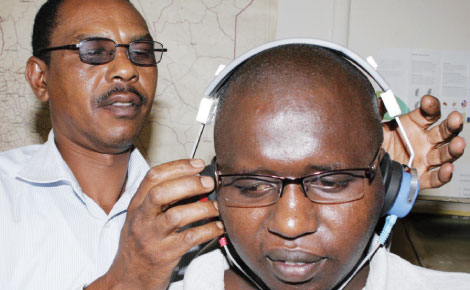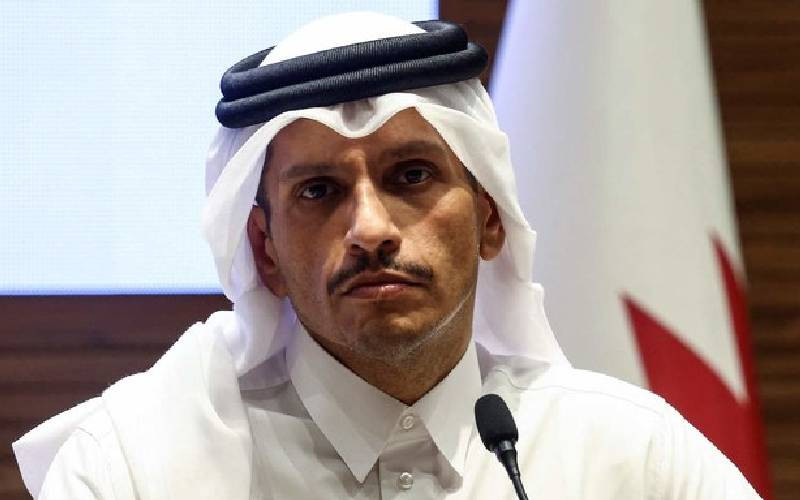 |
|
Nicholas Zacharia, technician at the society fits a hearing gadget on this writer. PHOTOS: KIBIWOTT KOROSS] |
By Kibiwott Koross
Kenya; Walking from her computer, Caroline Obwago leads us to our seats. One cannot immediately tell she is deaf.
“She has been a secretary here for more than ten years,” reveals Makarius Kathenya, Kenya Society for Deaf Children (KSDC) director. The 37-year-old sat her Kenya Certificate of Primary Education at Nyang’oma School for the Deaf in Siaya County and did her Kenya Certificate of Secondary Education at Mumias Secondary School for the Deaf.
She is among the lucky few deaf people to have acquired secondary education according to KSDC chairman Francis Ng’ang’a. He says over 90 per cent of deaf children do not go to school.
“Our survey recently showed there were about 200,000 deaf children across the country. If only 8,000 are in school, where are the rest,”? He posed. He however, admits there are few schools for the deaf.
The are about 20 secondary and 105 primary schools for the deaf in the entire country, most lacking teaching aid and teachers.
Hanna Salim, Principal of Karen Technical Training School for the Deaf says the school has been running in arrears as the Sh2,000 sponsored by the Government per student quarterly is only enough to pay teachers employed by the board.
“We can’t send the students home, that would be like condemning them,” says Salim. She says the school has been surviving on grants and donations. The school is the only one offering post-secondary education for the deaf countrywide.
It has 179 students, out of which 140 have hearing impairment. She however, says despite some students excelling, they do not get jobs owing to discrimination by potential employees.
In an interview with The Standard on Saturday, Ng’ang’a challenged the Government to put up more schools for the deaf. KSDC, he says, will also push for establishment of a university for the deaf. There is none in Africa. “We are nonetheless looking forward to the day a university for the deaf will be built,” he added.
Accept and help
Director of Basic Education, Leah Rotich says they are consulting with Treasury to release funds for development in special schools.
“We have not had any money for development in special schools. Considering that most of them are run by non-governmental organisations, the government has not been funding these schools but once Treasury approves our budget, we will fund them,” Rotich said in a phone interview. Kathenya says the Government has abandoned the deaf children.
He says there are very few teachers and urged the government to train and employ more teachers for the deaf.
“It is like these children have been neglected. The society should also accept and help them,” he says. Kathenya says the ratio of teacher to pupils for deaf children is wanting.
Stay informed. Subscribe to our newsletter
“The policy says one teacher should handle 12 pupils, but a teacher currently handles an average of 30,” he lamented.
Elkana Lagat, the Kenya Institute of Special Education director, however says they have trained enough teachers. “There are more teachers taking Special Education courses and I am sure they are enough to serve all the special schools,” he added.
According to World Health Organisation estimates, ten per cent of any populations are people with disabilities.
However, the figures are higher for developing countries, where the number ranges from 15 to 25 per cent. With about 38 million people as of 2009 Ministry of Planning census, those with disabilities could be between three to 7.5 million.
These include specific disabilities such as hearing impairment, physical handicap, visual impairment, deaf, blindness and mental handicap among others.
Other infections
A research by the Kenya Society for the Deaf in 1998 showed that about 6.3 per cent of Kenya’s population, translating to 1.9 million has hearing impairment. Most of this cases; the research says, are found in poverty stricken areas like former North Eastern Province, Turkana and informal settlement schemes.
Children born near noisy places are also likely to be develop hearing problems because of the high compression inside the ear, which bursts their drums.
Kennedy Kirwa, an ear, nose and throat specialist says other than noise pollution, the hearing impairment can also be caused by infectious diseases like syphilis, HIV/Aids and diabetes from mother to an unborn child.
“There are also diseases like meningitis, malaria, mumps, whooping cough and other infections in the ear such as otitis media (where pus comes out of the ear) which could lead to hearing loss,” explains Kirwa.
He says most patients referred to him are from slums and mostly under the care of children’s homes.
“Most are from Mathare and Mukuru Kwa Njenga slums. Some have inflammations with impacted wax in the ear, a condition that can be handled with proper hygiene,” he concludes.
 The Standard Group Plc is a
multi-media organization with investments in media platforms spanning newspaper
print operations, television, radio broadcasting, digital and online services. The
Standard Group is recognized as a leading multi-media house in Kenya with a key
influence in matters of national and international interest.
The Standard Group Plc is a
multi-media organization with investments in media platforms spanning newspaper
print operations, television, radio broadcasting, digital and online services. The
Standard Group is recognized as a leading multi-media house in Kenya with a key
influence in matters of national and international interest.
 The Standard Group Plc is a
multi-media organization with investments in media platforms spanning newspaper
print operations, television, radio broadcasting, digital and online services. The
Standard Group is recognized as a leading multi-media house in Kenya with a key
influence in matters of national and international interest.
The Standard Group Plc is a
multi-media organization with investments in media platforms spanning newspaper
print operations, television, radio broadcasting, digital and online services. The
Standard Group is recognized as a leading multi-media house in Kenya with a key
influence in matters of national and international interest.






